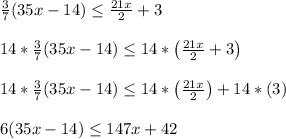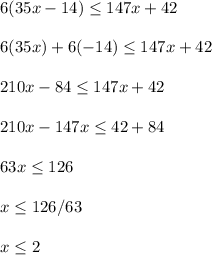Answer:
You'll have a closed circle at x = 2, and shading to the left
See the diagram below
=========================================================
Step-by-step explanation:
The fractions here are 3/7 and 21/2. The denominators of which are 7 and 2 respectively. The LCD is 7*2 = 14.
If we multiply both sides by 14, then this will clear out the denominators and make the fractions go away.
- 14*(3/7) = (14*3)/7 = 42/7 = 6
- 14*(21/2) = (14*21)/2 = 294/2 = 147
So if we multiplied both sides by 14, then we have these steps

--------------------------
Let's isolate x

The graph of this will consist of a closed or filled in circle at x = 2. We shade to the left to represent numbers smaller than 2.
So either x = 2 or x < 2.
If we used an open hole at 2, then we wouldn't be including 2 (but we want to include this endpoint).
See the diagram below.